Freshwater snails are very often considered pests, though there are several species that are kept and bred for their utility and ornamental value.
The fact is, all species of snails kept in aquariums have their own use, even those “pest” ones! Even in planted tanks, snails are a beneficial addition to your aquarium.
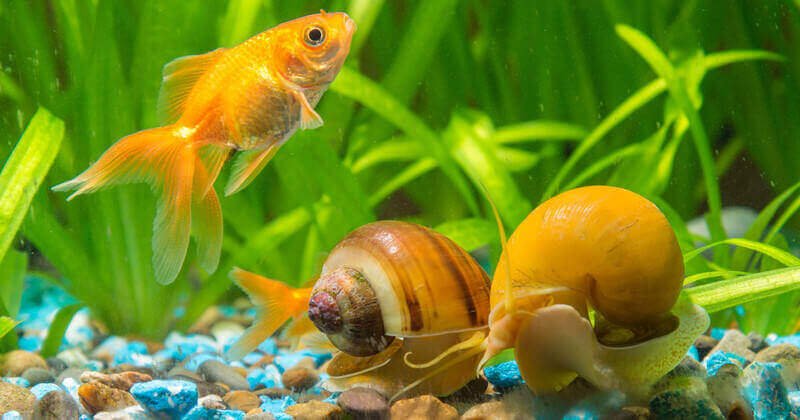
Aquarium snails have a lot of variety, they each have their own dietary preference and habitat in the tank.
Some prefer algae and live vegetation, some prefer decaying plant matter, some are carnivores, and some eat a bit of everything! So knowing their diet can play a large role in how long they live in your tank.
Many snails will also burrow in your substrate and have the benefit of removing detritus and aerating your gravel or sand. This helps with aquarium maintenance and prevents the build up of phosphates.
When plant matter or fish food decays, it releases phosphate. This is prime algae food, so keeping your phosphate levels low is important!
Snails need a certain amount of minerals in the water (mostly calcium) so maintaining a proper hardness level is important. This is as easy as doing a simple water test, and adding a hardness buffer (to raise your hardness) or mixing in RODI/distilled water (to lower it).
So which snails are best for your tank? We’ll go through common species to help you choose.
Types of Aquarium Snails
1. Apple Snails – Pomacea sp. (Mystery Snails, Inca Snails)
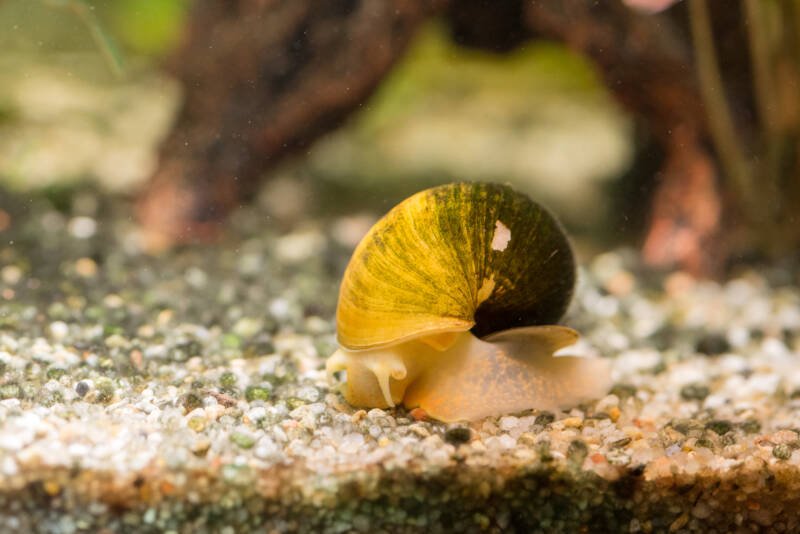
- pH: 7.0-8.0
- dgH: 4-18
- Temperature: 65-80°F (18-26°C)
- Size: 2″ (5cm)
- Diet: Algae, decaying plants, some fresh vegetation.
Snails in the genus Pomacea have several common names. There are a few species in the genus sold on the market but all have very similar care. The most common species is Pomacea diffusa.
Apple snails are native to the Americas and vary in size from 2-6″.
They are excellent algae eaters, they also eat decaying plants. Being gonochoristic, they are male and female separately. This means unlike many snails (which are typically hermaphroditic) you need both a male and female snail to breed. They are also slower to reproduce than other aquarium snails.
This does not mean they are challenging to breed, since they will lay 200-600 eggs at a time! There are several color varieties as well including gold, blue, pink, and ivory. Many species will lay their eggs above the water level. These snails are very common tank mates with betta fish and goldfish.
Have a look at our in-depth Mystery snail care guide!
2. Rabbit Snails – Tylomelania zemis
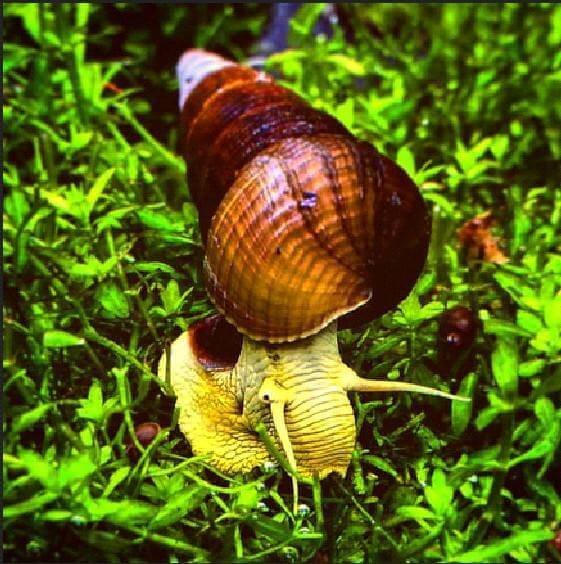
Image Source: flickr
- pH: 7.0-8.0
- dgH: 4-18
- Temperature: 75-80°F (23-26°C)
- Size: 2″ (5cm)
- Diet: Algae, decaying plants, some fresh vegetation.
Rabbit snails are another slightly larger species of snail, unlike the apple snail however they are avid burrowers. Their long cone shaped shells are a giveaway of this behavior. They are less commonly available and come in different color varieties.
Native to Sulawesi, India, there are many species in this genus. zemis is most commonly available. They are excellent algae eaters and for the most part, leave live plants alone. However, like with any snail, if they have been starved they will try to eat anything they can.
They are another slow reproducer. Rabbit snails will lay a single egg at a time! Inside this egg is a single embryo that will hatch. The eggs are pearly white (sometimes with a blue tinge) and smaller than a pea. They are laid in or on the substrate. Because of this, there is little chance of them taking over your tank.
3. Devil Spike Snails (Faunus ater)

- pH: 7.0-8.5
- dgH: 8-18
- Temperature: 70-78°F (21-25°C)
- Size: 3″
- Diet: Algae, decaying fish/shrimp/plants, live plants.
Despite their scary name, these snails are harmless! Well, unless you are a plant. Unlike most snails in this article these guys will eat live plants. So they are not safe for a planted aquarium.
They are similar in appearance to rabbit snails, however the apex is much sharper and the shell in general is smoother.
These snails also get slightly larger. They burrow as well as clean the glass of algae and scavenge for decaying matter.
Do not worry about these snails taking over, they do not reproduce in freshwater! There is not much known about their reproduction but they we do know they need brackish water to trigger breeding.
These snails are an excellent clean up crew for tanks without plants.
4. Japanese Trapdoor Snails (Viviparidae)
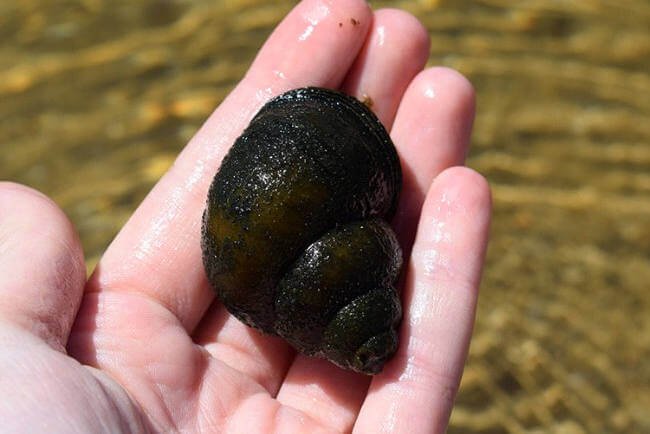
- pH: 7.0-8.0
- dgH: 4-18
- Temperature: 65-80°F (18-26°C)
- Size: 2″ (5cm)
- Diet: Algae, decaying plants, some fresh vegetation.
These snails are a less common but interesting and useful snail in the hobby. They are a moderately sized snail and native to Asia and Europe. Snails in this family are viviparous meaning they give live birth. Many snails have an operculum, but the trapdoor snails does a good job of covering the vulnerable fleshy body as it retracts in it’s shell. In many ways, this is a similar snail to the Apple snail.
5. Nerite Snails (Neritina sp.)
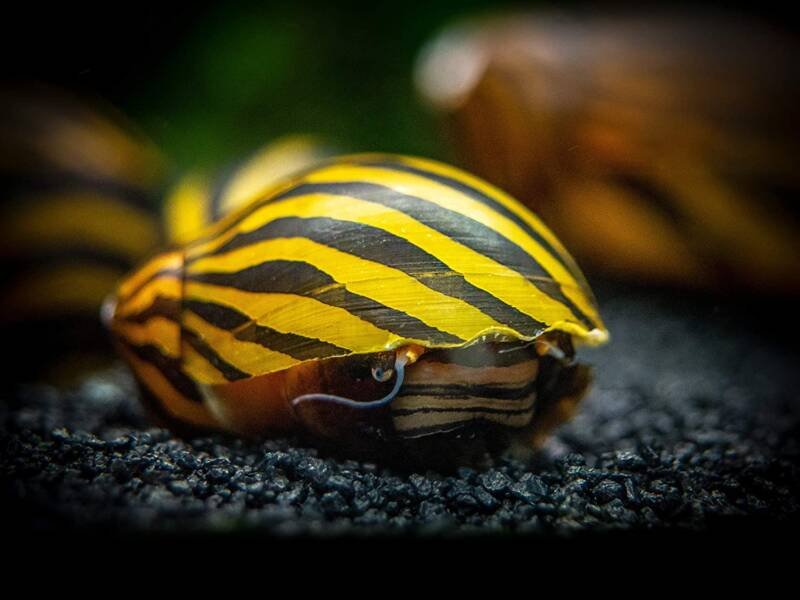
- pH: 7.0-8.5
- dgH: 8-18
- Temperature: 70-85°F (21-29°C)
- Size: .5-1.5″ (1-3cm)
- Diet: Algae, diatoms, decaying plants, some fresh vegetation.
Nerite snails are often boldly patterned snails that are most well known for their diet including brown algae (diatoms). Most other algae eaters won’t touch diatoms, making nerites unique and quite useful!
They are another snail that will not reproduce in freshwater. In fact there are many species of nerite snails that are saltwater animals. Your most commonly seen species of nerites can live comfortably in both fresh and brackish water aquariums.
Because of this, they do not tolerate soft water (water lacking in calcium). While they do not successfully reproduce in freshwater, they will still lay eggs. These eggs are white and highly calcified, which can sometimes be unsightly and can take some effort to remove from glass and decor.
There are several species seen in the pet trade of nerite snails. Some have stripes, some have broken lines, and some even have horned shells! These are beautiful exotic looking snails that are an excellent choice for many tanks.
6. Ramshorn Snails (Planorbidae and Ampullariidae)
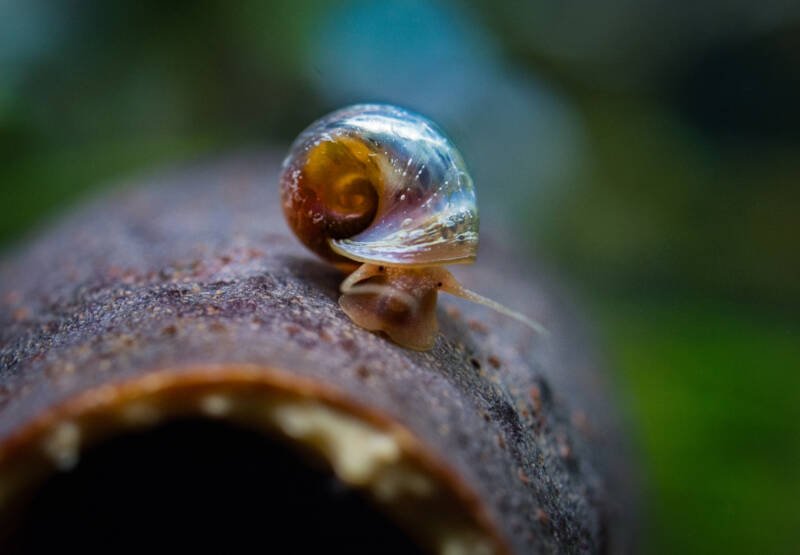
- pH: 6.5-7.8
- dgH: 4-18
- Temperature: 70-85°F (21-29°C)
- Size: .5″ (1 cm)
- Diet: Algae, decaying plants, some fresh vegetation, dead fish or shrimp.
Ramshorn snails are a smaller species of snail and are sometimes considered pests! This is because of their high reproduction rate. However, they are excellent janitors are have been bred to have interesting shell colors like blue, red, or white. There is also a species with a reddish body color!
They are easily available in the pet trade and easy to breed. Keeping a colony in your planted tank is as simple as adding a handful and waiting a month or two! They help keep algae down and eat decaying plants, which helps your live plants thrive.
However, as with any snail, if there is not enough food in the tank they will start to eat live plants. So it’s important to supplement their diet if you start to see bite marks on your leaves!
7. Assassin Snails (Anentome helena- previously Clea helena)
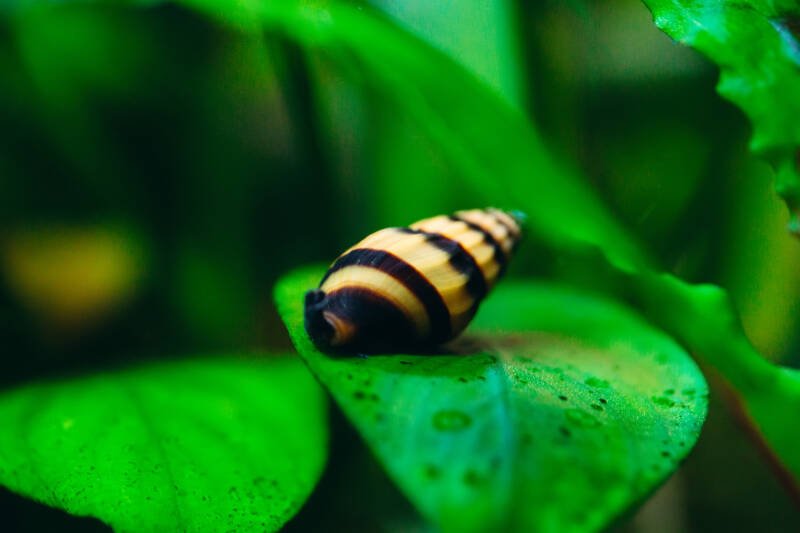
- pH: 6.5-7.8
- dgH: 4-18
- Temperature: 70-85°F (21-29°C)
- Size: .5″-1″ (1-2cm)
- Diet: Algae, decaying plants, some fresh vegetation, dead fish or shrimp.
Assassin snails are a wholly unique snail to keep in your freshwater aquarium. They have a boldly patterned shell made up of black and yellow swirls. They are longer in body shape which allows them to burrow easily.
This snail gets it’s name from it’s diet- other snails. That’s right, this is a predatory snail! It will track down, kill, and eat, any aquarium snail it can. As you can imagine, this makes it an excellent choice for removing unwanted snails from a tank!
Once the snail population is depleted, these snails will need supplemental feeding in the form of bloodworms, shrimp, fish flakes, or other meaty frozen or dry foods. They reproduce easily in a tank but typically will not “take over”. This is an amazing species and an excellent choice for removing pest snails.
8. Malaysian Trumpet Snails (Melanoides sp.)
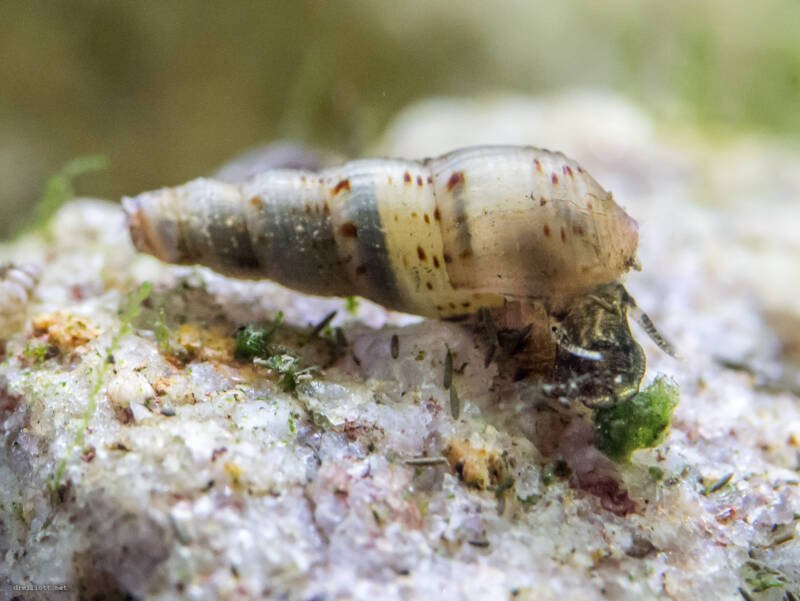
- pH: 6.0-7.8
- dgH: 4-18
- Temperature: 70-85°F (21-29°C)
- Size: .5″-1″ (1-2cm)
- Diet: Algae, decaying plants, some fresh vegetation, dead fish or shrimp.
Malaysian trumpet are commonly thought of as pest snails because their population does get quite high in most tanks. However, they are a useful and beneficial snail to have in the planted tank. They stir up the substrate with their burrowing behavior and eat decaying plant matter, helping to keep algae down.
There are four species in the genus that are commonly seen, all of which are native to Africa and Asia and stay .5-1″ long. They spend most of the day burrowed in your substrate and come out at night to scour the tank for food.
While all species are cone shaped, there are several different colors and patterns. They make great tank mates for shrimp and most tropical tanks, aside from those containing loaches. There are several species that will devour trumpet snails!
9. Pond Snails (Lymnaeidae) and Bladder Snails (Physidae)
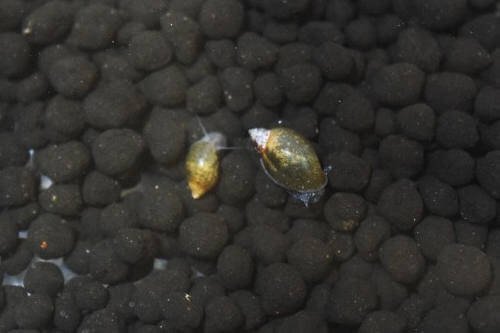
Bladder snail on the left, pond snail on the right
- pH: 6.0-8.0
- dgH: 4-18
- Temperature: 70-85°F (21-29°C)
- Size: .5″ (1cm)
- Diet: Algae, decaying plants, some fresh vegetation, dead fish or shrimp.
Pond snails and bladder snails are often confused for one another, but there are differences! Bladder snails are in my experience more commonly seen. They are smaller, have a blunter and shorter apex, and longer thinner antennae. Both types of snails reproduce readily in aquariums and are the most common “pest” species.
However, they are excellent algae eaters and keep planted tanks looking beautiful. They are also great scavengers and will eat any detritus or mulm in the tank, helping to keep it clean. They are recommended tank mates for shrimp, betta fish, and most tropical tanks.
Their egg cases are about 1/4″ long clear jelly-like sacks full of small whitish eggs. These hatch into tiny fully formed snails that are in my opinion quite fast- for snails. Many tanks will have a population of one or both types of snails and have no ill effects, even if their numbers are high!
Snail Care
Most freshwater snails have similar care. They are largely tolerant of nitrate levels (<20ppm) but do not tolerate ammonia or nitrite in their water at all. Because of this, they are best added to a cycled tank or pond.
General hardness is measured in degrees of general hardness (dgH). Water with lower levels of hardness are considered “soft” while higher levels are considered “hard”.
- 0-3 soft
- 3-6 moderately soft
- 6-12 slightly hard
- 12-18 moderately hard
- 18-25 hard
- >25 very hard
pH is important as well, though it is not as impactful on their shell health. Most snails prefer a neutral (7.0) to more alkaline (>7.0) environment.
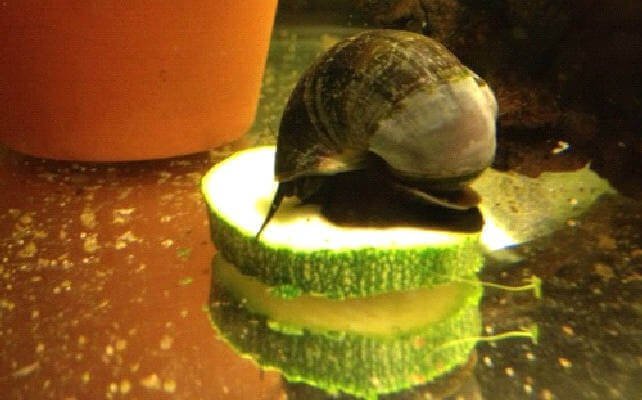
Oxygen is important, like with all aquatic inhabitants. Snails can actually be a good indicator of low oxygen levels as they will congregate to the top of the tank, where there is more oxygen. Some will even use a siphon to get oxygen from the air above the tank! This is mostly seen in amphibious species.
With the exception of assassins, snails will do well with a good amount of algae in their tank. However, they can also be fed a variety of vegetables such as:
- Zucchini
- Cucumber
- Blanched spinach
- Blanched carrot.
They will also accept a range of dry foods made for bottom feeders, such as algae discs or shrimp pellets. In fact, being scavengers, snails will typically eat any food that makes it’s way to the bottom of the tank.
Snails don’t need to be fed every day, since a good part of their diet is algae. Most often you’ll want to feed your snails two to three times a week, being sure to remove any uneaten food after 24 hours.
Water flow should be minimal to average in your tank, and you should typically not need anything like a powerhead to achieve this. An average aquarium filter is going to provide your tank with enough flow for any snail.
Breeding Snails
To breed snails, you’ll need to create an environment they can live safely. This means a lack of predators and access to food. Typically, if you put them in a tank within their preferred parameters, they will breed readily! Eggs are often laid on the glass but some are deposited under the substrate or above the water level.
If you see snail eggs, you can either ignore them or remove them if you want to keep your population down.
Snail eggs can look like:
- A clear gelatinous sack with small white eggs inside
- A single pearl-like egg
- Hard solid white domes laid on glass, decor, or plants
- Matte pinkish or white clusters above the water, on the glass or tank lid
Before you start breeding snails, and if you plan on selling to your local fish store. Call them first. Ask them what species and color of snails they would like, and go from there. You can of course breed any snail you’d like but if you have no one to buy them you might be stuck!
I would also recommend only keeping one color together if you’re serious about breeding. That way you know what colors to expect and you won’t have any mixes to throw off your breeding project.
Typically, a 10 gallon tank will be large enough to create a decent colony of snails. However, for larger species like rabbits, apple, trapdoor, and devil spike snails, I would recommend using a 20 or 30 gallon.
Once you have an established colony you can start selling online or to your local fish store. This can be rewarding and educational, and even a fun project to do with your kids.
Snail Tank Mates
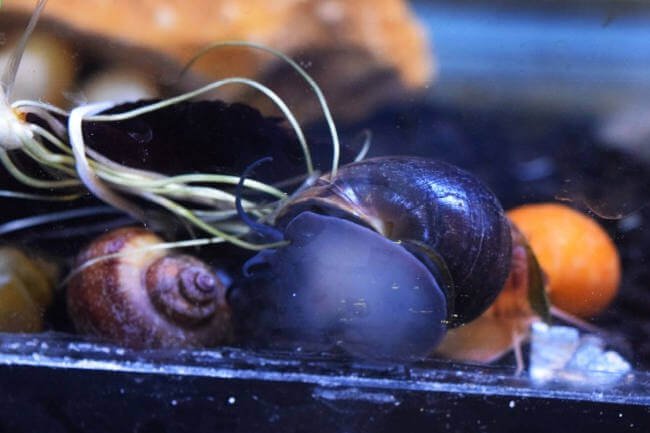
Snails are safe to keep with many fish, but there are some that will happily eat them! These fish should never be kept with snails and you should consider a different type of algae eater for your aquarium.
- Any species of pufferfish
- Most loaches
- Most botias
- Oscars
- Most African Cichlids
Good tank mates that will not disturb your snails include:
And most tropical community fish. Snails can also be kept together, it is common for aquarists to mix different species to get a wider range of algae removal.
Cautions With Snails
All invertebrates are sensitive to copper. Many medications for parasites contain copper and if used in a tank with snails, will kill them! Some fertilizers can also contain copper, and if there is too much it can kill snails off as well. So be cautious when adding any medications to your aquarium. Check the label for any warnings about invertebrates.
A piece of foam, nylon stocking, nylon filter bag, or even a fish net cut to size and held in place by a rubber band will do the trick.
Closing thoughts
Most of the time they end up in tanks by mistake, but they really can be a blessing in disguise! Their ability to clear a tank of algae and detritus is unparalleled except by the more delicate Neocaridina shrimp.
Breeding aquarium snails can also be quite rewarding. There are many color varieties of easily bred snails such as Apple snails and Ramshorn snails. You can breed them for fun or for profit, selling them online or to your local fish store.
In fact, I recommend breeding assassin snails. They are in high demand and are easy to breed. Once you have a tank established with them you can make some money!
If you have any comments or questions about snails, leave them below!
Sources:
https://en.wikipedia.org/wiki/Viviparus_viviparus
https://www.applesnail.net
https://en.wikipedia.org/wiki/Clea_helena
https://users.cs.duke.edu/~narten/faq/chemistry.html
NavigationTypes of Aquarium Snails1. Apple Snails – Pomacea sp. (Mystery Snails, Inca Snails)2. Rabbit Snails – Tylomelania zemis3. Devil Spike Snails (Faunus ater)4. Japanese Trapdoor Snails (Viviparidae)5. Nerite Snails (Neritina sp.)6. Ramshorn Snails (Planorbidae and Ampullariidae)7. Assassin Snails (Anentome helena- previously Clea helena)8. Malaysian Trumpet Snails (Melanoides sp.)9. Pond Snails (Lymnaeidae) and Bladder Snails (Physidae)Snail CareBreeding SnailsSnail Tank MatesCautions With SnailsClosing thoughts

